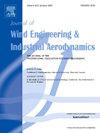大气稳定性评价作为城市大气污染物扩散的预测指标
IF 4.9
2区 工程技术
Q1 ENGINEERING, CIVIL
Journal of Wind Engineering and Industrial Aerodynamics
Pub Date : 2025-09-05
DOI:10.1016/j.jweia.2025.106221
引用次数: 0
摘要
本研究旨在建立一种基于真实城市条件下大气稳定性评价的大气污染环境评价新方法。利用多普勒激光雷达的风速、东京塔的温度数据和天气研究与预报模拟估算的地表温度计算梯度(Rg)和体积(Rb)理查德森数作为大气稳定性的定量指标。研究了Rg和Rb的范围、发生频率、季节/小时变化以及两者之间的相关性。当Rg评价高度设置为100m左右时,Rg和Rb的季节和日变化趋势基本一致。然而,Rg表现出比Rb更大的变异性,可能是因为Rg与风速梯度的平方成反比。还将Rb与Pasquill分类进行了比较,以评估它们的相关性和季节/小时变化。虽然Rb和Pasquill分类大致一致,但Rb提供了更详细和定量连续的大气稳定性表征。相比之下,Pasquill分类明显高估了中性状态“d类”的频率,特别是在阴天或过渡时期,并且经常错误地将弱和强稳定/不稳定状态分类为中性。此外,考虑到垂直风速廓线在城市污染物扩散中的关键作用,基于Rb和Pasquill分类对风速廓线进行了分析。两种分类均表明,随着大气稳定性的降低,平均风速垂直廓线的幂律指数减小,湍流强度增加。本文章由计算机程序翻译,如有差异,请以英文原文为准。
Evaluation of atmospheric stability as a predictive index for air pollutant dispersion in urban areas
This study aims to establish a new environmental assessment method for air pollution based on atmospheric stability evaluations under real urban conditions. Wind speed from Doppler lidar, temperature data from the Tokyo Tower, and ground surface temperatures estimated from Weather Research and Forecasting simulations were used to calculate the gradient (Rg) and bulk (Rb) Richardson numbers as quantitative indicators of atmospheric stability. The study investigates the range, frequency of occurrence, and seasonal/hourly variations of Rg and Rb and the correlations between the two indices. When the evaluation height for Rg was set to approximately 100m, the seasonal and diurnal trends of Rg and Rb were generally consistent. However, Rg exhibited significantly greater variability than Rb, likely because Rg is inversely proportional to the square of the wind speed gradient. Rb was also compared with the Pasquill classification to assess their correlation and seasonal/hourly variations. While Rb and the Pasquill classification were broadly consistent, Rb provided a more detailed and quantitatively continuous representation of atmospheric stability. In contrast, the Pasquill classification significantly overestimated the frequency of neutral conditions “ClassD”, particularly under overcast skies or during transition periods, and often misclassified both weakly and strongly stable/unstable states as neutral. Furthermore, given the critical role of the vertical wind speed profile in pollutant dispersion within urban areas, wind speed profiles were analyzed based on both Rb and the Pasquill classification. Both classifications showed that as atmospheric stability decreased, the power-law exponent of the vertical profile of mean wind speed decreased, while turbulence intensity increased.
求助全文
通过发布文献求助,成功后即可免费获取论文全文。
去求助
来源期刊
CiteScore
8.90
自引率
22.90%
发文量
306
审稿时长
4.4 months
期刊介绍:
The objective of the journal is to provide a means for the publication and interchange of information, on an international basis, on all those aspects of wind engineering that are included in the activities of the International Association for Wind Engineering http://www.iawe.org/. These are: social and economic impact of wind effects; wind characteristics and structure, local wind environments, wind loads and structural response, diffusion, pollutant dispersion and matter transport, wind effects on building heat loss and ventilation, wind effects on transport systems, aerodynamic aspects of wind energy generation, and codification of wind effects.
Papers on these subjects describing full-scale measurements, wind-tunnel simulation studies, computational or theoretical methods are published, as well as papers dealing with the development of techniques and apparatus for wind engineering experiments.

 求助内容:
求助内容: 应助结果提醒方式:
应助结果提醒方式:


